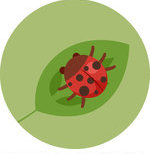Community
Connect with people who have similar genotypes and phenotypes as you!
Sign in to add a comment
-

VDR Bsm and VDR Taq
I'm having trouble understanding the consequences of SNPs in these 2 versions of vit D receptor genes. For starters; Genetic Genie reported that I'm VDR Bsm +/+ and, per definition, VDR Taq -/-. On their website they explain that these 2 normally are inverse to each other (althought this is not always the case, they state). But then, Livewello reports me being +/+ on both Bsm and Taq, and so does Nutrahacker.
How can this be? Is there a mistake in the reports of either Genetic Genie, or Livewello and Nutrahacker? And if so, or if not, what are the consequences for me? I think that in case of a -/- Taq SNP, one has to take extra vitamin D. But I also read that +/+ Bsm should not take too much vitamin D because they will risk auto-immune issues. So, because the reports on my Taq status are not reliable I do not kwow whether I NEED al lot of extra vit D because of -/- taq (knowing that low vit d status can lead to all sorts of diseases including auto-immune), or should not supplement at all because of the auto immune risk with +/+ Bsm.
Ik haven't been able to find any information on this subject.
Can anyone clarify this for me?
It's worth adding that I've seen the same reports for a friend of mine, and in his case the 3 before mentioned variance reports were also inconsistent regarding VDR Bsm and Taq status. It is not just me and my reports that are puzzling.
Thanks!- 10 years, 6 months ago
-

TA7344
@WE6588 I have the same VDR Bsm as you, ++ and VDR Taq --. I, too, am not sure what it all means. My son has VDR Bsm +- and VDR Taq +-. After looking at his, his is not inverse. He and I take a Vitamin D3 supplement nearly every day, and it seems the only time my D3 absorbs from the sun is when I go to Florida on vacation and lay in the sun. I live in TX, and I can be in the sun a lot and for some reason, I've had to start (4 yrs ago after being diagnosed with Hashimoto's Thyroiditis) and keep taking a supplement.
The whole thing confuses me to no end. I am not sure what to do either. As long as I keep taking my D3, I do have a higher D3 count, that is all I know. If you find out anything else, please post it. Sorry I couldn't help you...I can't even help myself with the knowledge.- 8 years, 3 months ago.
-

WE6588
This is what I found on SNPedia as Yasko Methylation
https://www.snpedia.com/index.php/Yasko_Methylation
VDR Gene
rs1544410 - VDR Bsm (Risk Allele: T)
rs731236 - VDR Taq (Risk Allele: A)
VDR Taq TT --> AA +/+
VDR Taq tt --> GG -/-
So in Yasko Methylation, VDR Taq is opposite to Livewello : Risk Allele is A, not G as in Livewello
Am I getting this right????Lol- 8 years, 3 months ago.
-
Rhonda lea kirk Fries
I don't know if this will contribute to understanding or if it will make everything worse, but here are my notes on VDR from the last time I tried to figure out the nomenclature. Source links included. I don't think the first is especially helpful to the purpose here, but I left it in for anyone who might have an interest.
http://www.ncbi.nlm.nih.gov/pubmed/23065592
VDR TaqI and VDR BsmI are associated with autoimmune thyroid disease. Decreased risk of AITD for the major allele of VDR BsmI (G) and the minor allele of VDR TaqI (C).
http://cebp.aacrjournals.org/content/18/11/2874.full
(See section entitled "DNA Extraction and Genotyping"
Based on standard nomenclature, genotypes for the four VDR variants, FokI (rs10735810), BsmI (rs1544410), ApaI (rs7975232), and TaqI (rs731236), were reported using lowercase and uppercase letters to reflect the presence or absence of a restriction site, which is consistent with the literature (FokI: T-f and C-F; BsmI: G-b and A-B; ApaI: T-A and G-a; and TaqI: T-T and C-t).
http://cebp.aacrjournals.org/content/15/12/2549.full
(See section entitled "Genotype Analysis")
Consistent with the literature, genotypes for the four VDR ... More- 9 years, 4 months ago.
-

TA7344
I see that this is a rather old post, so I don't know if my response will even get a reply or whatever. I haven't had my dna numbers sent to livewello, so I can't respond to anything there, but I have the same VDR bsm ++ TT and VDR Taq - - GG as the first poster above @RM5410. Reading the info from geneticgenie, it didn't really explain much, just that they were inverse. I am rather new to finding out my genes, so I have lots of questions. I am not very good at science, but I can pick up things quickly. Any ideas?
- 9 years, 10 months ago.
-
David Jessup
1I'm on this as ++, but I see that it depens on if the scientists agree what a mutation is or isn't, so which A, C, T, etc. it belongs to. Some are even race-dependent. D vitamins are nothing to mess with if you ask me. Have your kidneys and the parathyroid functions checked before doing anything with that. It can suck calcium out of your bones or fry your kidneys if you mess with the wrong stuff.
- 10 years, 5 months ago.
-
Tom Ballard
1I don't know Yasko's position, but would suggest looking at the material you're reading for a date. Possibly you're looking at something that was published 3-10 years ago and, as you know, the research is changing daily.
Tom Ballard, ND- 10 years, 6 months ago.
-

YQ1074
RM-5410, thanks for posting Yasko's comments on the VDR SNPs. I had read that last year, but couldn't find it now. However, it doesn't totally clarify what her position is on SNP nomenclature. She is using T for "unrestricted" VDR taq and t for VDR taq with a "restriction site." I have always thought that upper case applied to the major (most frequent) allele and lower case applied to the minor (least frequent) allele. Not sure of the basis for that assumption, it may be comparable to the Livewello assumption, usually but not always true. All I know is that I am homozygous for the minor allele of both VDR Bsm and Taq, and I have achieved a 25OHvitaminD level of 60-70 ng/ml by supplementing with 10,000 IU of vitamin D3 per day. That may be a higher dose than most, indicating that maybe my VDR is not very well expressed. Also, I have no trouble taking in a high dose of methyl groups. My biggest difficulty arose with a high dose of folic acid and hydroxocobalamin, which combined with my compound heterozygous MTHFR status, caused me to be even more undermethylated than I normally ... More
- 10 years, 6 months ago.
-
Tom Ballard
1Applying genetics to your health can be very frustrating because it's so new with many unknowns AND because it is only one piece of the three-legged stool. A person's health is reflected in their lab tests (including genetics), but also their health history and physical exam. It's easy to get caught up in treating the genes rather than the whole person - and this is encouraged by those selling drugs and supplements.
In my experience of doing comprehensive genetic reports over the years, VDR is very common, but not as important as other gene variations. When a patient of mine has a VDR SNP, I consider a serum vit D and calcium test and bone density. But even with this information there isn't necessarily a slam-dunk diagnosis, as blood will steal calcium from bones under acidic conditions and bone density problems won't show up until fairly advanced. If the person is still young, they won't know there's a problem for maybe decades.
That's where taking in the whole picture is important: is this patient also not exercising, therefor reducing bone formation? Do they eat a high sugar diet, which makes them more vulnerable ... More- 10 years, 6 months ago.
-

RM5410
I found a text writting apparently by dr Yasko herself about VDR. She repaeatedly says that it is all very complicated and that there is disagreement. But she also says that low dose vit D + rosemary, sage and resveratrol are good for every geneotype.
Dr Amy Yasko:
"VDR information:
Recently there has been a barrage of questions related to VDR. The situation with respect to VDR is highly complex which is why I have not tried to thoroughly explain it in the past. I have tried to keep it simple for you and note the observed clinical relationship between those who cannot tolerate higher levels of methyl donors (tt) and those that can handle more methyl donors (TT) in terms of their Taq status. Based on the volume of questions and confusion regarding VDR I will go ahead and explain the complexity of the situation.
I believe this recent flurry of interest in the genotype designations for the VDR is related to of the use of GcMAF. While initially it was thought that the VDR SNP data played a role in determining the use of that agent, it has since been suggested that simply the use of Vitamin D may ... More- 10 years, 6 months ago.
-

RM5410
Tom, I alread did that. I am GG. But as YQ-1074 pointed out, researchers don't seem te agree upon wich allele is the risky one: A or G. So unfortunately, my raw data don't help. I've seen many online discussions in the mean time about Yasko treating this SNP differently then others do. But no one on those forums really understands what this all means for a specific genotype. I even came across a doctors website on which he/she argued that the SNP today actually is more common then the (formerly) wild type/good gene (thus: agreeing on this with Yasko) because we are overexposed to calcium nowadays. And less vitamin D would be helpful so that the excess calcium doesn't go where it isn't supposed to go (like on your arterial walls and in soft tissues). Another problem I come across is the inconsistency in nomenclature. e.g. a respectable German lab that does genetic research hasn't even heard of genes being indicated as an rs number. The dr I spoke to could not compare my gene report ot her knowledge base because of that.
So, I gues, it seems that my ... More- 10 years, 6 months ago.
-

NO3151
Just remembered, that VDR is an upregulated gene, may thats why Yasko is treating it differently.
- 10 years, 6 months ago.
-

-
Tom Ballard
Again, When in doubt, go to the source. Look at your 23andme raw data. It will also link you to research. If you don't know how, here's a video that explains how to do that. https://www.youtube.com/watch?v=rNK_vZu9qDA.
- 10 years, 6 months ago.
-

NO3151
The question is, if only VDR is 'switched/bad/good' or whatever, or other genes may be questioned as well? As we do have as base for comparison only Yasko report from here/LW compared to Yasko/knowyourgenetics - is the only one black-sheep.....
- 10 years, 6 months ago.
-

-

YQ1074
1You are probably GG for rs731236, as I am. G is the minor allele for this SNP, with a global frequency of 0.2766. Livewello assumes that the minor allele is always the risk allele, so they have you as +/+. On the other hand, Geneticgenie follows Yasko, and she thinks the risk allele is the major allele, A, so she and Geneticgenie have you as -/-. Your alleles haven't changed, but the risk allele is different between the two sources. I think that Yasko is probably right, the minor allele is usually but not always the risk allele. I assume that she has studied the issue and has a basis for her opinion, whereas as far as I can deduce, Livewello just makes the blanket assumption that minor=risk, and I think that's an oversimplification. There is a discussion of this issue with this SNP on Yasko's website if you can find it.
- 10 years, 6 months ago.
-
Tom Ballard
When in doubt, go to the source. Look at your 23andme raw data. Here's a video that explains how to do that. https://www.youtube.com/watch?v=rNK_vZu9qDA
- 10 years, 6 months ago.
-

DI7336
There is a way to manually confirm your results for LiveWello but I don't know about the other companies. LiveWello gets your phenotype by comparing your genotype with the minor allele of a SNP. These minor alleles can be found at dbSNP. So to manually verify your result, look up the minor allele on dbSNP and see how it matches against your LiveWello result. You should write all 3 companies then post their answers here so all can learn about this important question.
- 10 years, 6 months ago.
-

RU1316
I suggest you ask both companies about this discrepancy. You are not the only one that has noticed these discrepancies and it would be nice to post their answers here for everyone to see.
- 10 years, 6 months ago.
-